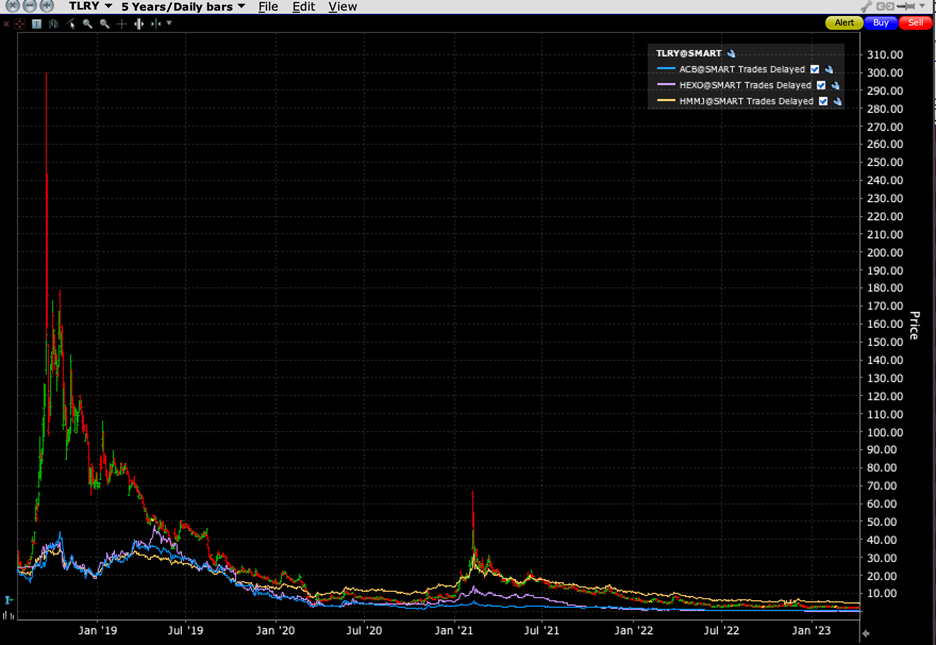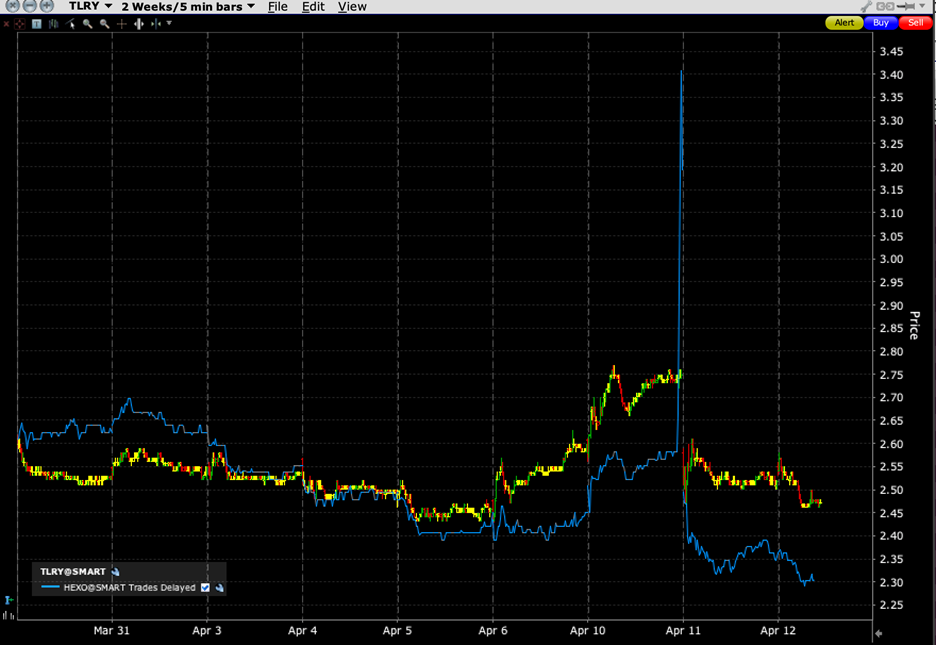Up In Smoke
Quick Quiz: What was by far the hottest market sector five years ago? Some hints: it was blazing hot; got too many advocates giddy; and burnt you if you held on for too long. The answer is of course cannabis stocks.
I really hadn’t thought much about them in quite some time until two pieces of news crossed my path recently. First was Monday’s announcement that Tilray (TLRY) would be acquiring Hexo (HEXO) in a no-premium, all-stock deal. Second was a circular that I received from the Toronto Stock Exchange yesterday announcing that two S&P/TSX Cannabis indexes will be decommissioned at the end of this month. Put together, they symbolize the ashes of a brief, euphoric market phase.
That was indeed a heady time, and as I coincidentally noted in yesterday’s piece, as options market makers in Canada we had a front-row seat to the reefer madness. There is a certain degree of chaos when one is trying to price options on stocks that move exponentially and are essentially impossible to borrow. Almost instantly our market-making focus shifted from the usual bank and resource names that typically dominate Canadian options trading to a list of newcomers that only just came to our attention: Aurora Cannabis (ACB), Canopy Growth (WEED in Canada, CGC in the US), Aphria (acquired by TLRY) and HEXO were among them. Canada was also the first out of the gate with a sector ETF, Horizons Marijuana Life Sciences (HMMJ), which caused no shortage of consternation about why the US funds couldn’t move quicker.[i]
Although TLRY was the market leader, so to speak, we didn’t get as heavily involved in those options. Even though it is based in British Columbia, its primary listing has always been in the US. In fact, TLRY was only formally listed on the TSX in May 2021 when it completed the Aphria merger. But its NASDAQ listing gave TLRY a huge potential investor base and no shortage of hype in US financial media, which led it to be the poster child for the Canadian weed sector.
A long-term chart helps put the hype and fizzle into perspective:
5-Year Daily Bars, TLRY (red/green), ACB (blue), HEXO (lilac), HMMJ (yellow)
(Click on image to enlarge)

Source: Interactive Brokers
TLRY burned the brightest and began to flame out first, while its peers had better-staying power throughout the rest of 2019. There was a brief bout of enthusiasm after Biden’s inauguration in early 2021 on hopes that long-awaited US legislative relief might arrive under a Democratic administration. That jump became more pronounced because it coincided with the height of meme-stock mania, but it proved to be only a short respite in a long-term trend has generally been toward irrelevance.
Quite frankly, this seemed inevitable. Cannabis companies are steadily unprofitable, and it is difficult to make a long-term investment case for any company with a continual track record of losses. One strategy that occurs in an unprofitable industry is consolidation; TLRY’s acquisition of HEXO, coming two years after it acquired Aphria, fits that theme.
The movement around the merger announcement shows both the residual hope and eventual resignation in the sector. As we noted, the share swap represented a no-premium deal for HEXO.In fact, because the ratio was based upon the 60-day volume-weighted average price of HEXO, it was actually a discount to HEXO’s current price when the deal was announced after the market close. However, at 3:47 BNN Bloomberg reported that HEXO would be acquired, which led to a huge spike in the stock price. Why anyone would pay a huge premium for the stock is a mystery, but giddy traders and news reading algorithms don’t offer time for careful analysis:
TLRY (red/green), HEXO (blue), 2-Weeks, 5-Minute Bars
(Click on image to enlarge)

Source: Interactive Brokers
For better or worse, we saw the end coming. As with bitcoin, one of my wife’s friends inadvertently called the top when she asked me how she should be investing in Canadian weed stocks. From that moment on, our strategy became one of selling rips rather than buying dips. And the lessons learned in one mania can be utilized in another. As noted above, meme stocks echoed the cannabis craze. Crypto was a more widespread mania at its height, but the pattern is the same.
It remains to be seen whether the current promise of AI morphs into a full-blown mania (if it hasn’t already), but when we consider that some of our most prominent companies are amongst its beneficiaries – Microsoft (MSFT) and NVDA (NVDA) come to mind – if the current enthusiasm for AI fizzles, it could have profound effects on key US indices.
[i] Let’s not forget that the ETF was invented in Canada. The TIPS Fund, based on the Toronto 35 Index, was listed in 1990, nearly three years before SPY became the first in the US.
More By This Author:
From Sizzle To Fizzle: Inflation Worries Reverse Market Rally
Back To My Future, With Glittering Gold
This Time I’m Glad That Banks Go First
Disclosure: ETFs
Any discussion or mention of an ETF is not to be construed as recommendation, promotion or solicitation. All investors should review and consider ...
more


